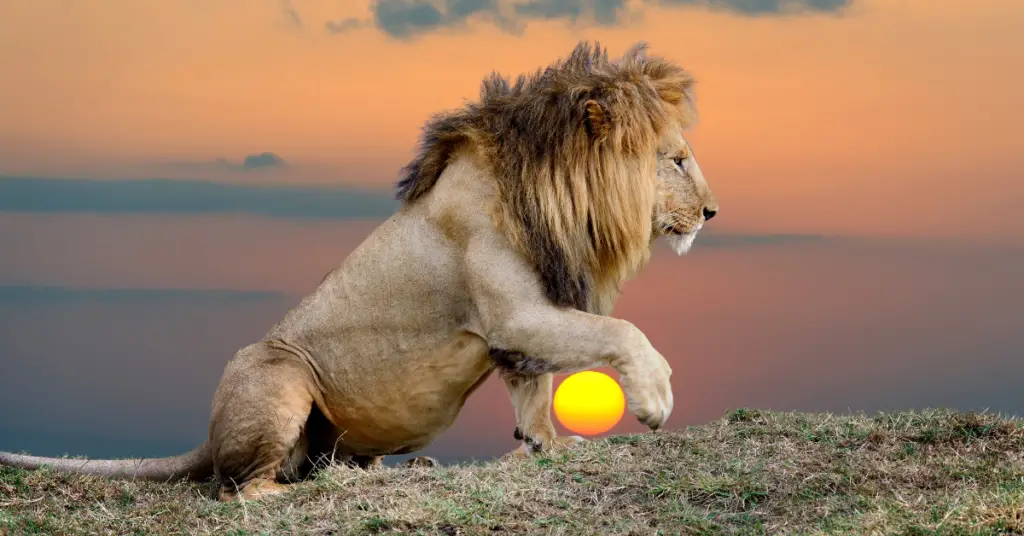GEOGRAPHIC RANGE: 28 African countries– mainly central and southern Africa.
HABITAT Savannah, meadows, and woods.
LIFESPAN 10-16 years in the wild Up to 30 years in captivity.
WEIGHT 110– 250 kg
WILD POPULATION: 20,000 individuals.
Two subspecies are currently recognized: the African lion (Panthera leo leo) and the Asiatic lion(Panthera leo persica). The Asiatic lion is a bit smaller than its African cousin and has a shorter, thinner mane and skin fold that runs the full length of the belly, which is rare in African lions. It has been suggested that there may in fact be six lion subspecies; however, Previously widespread throughout Eurasia and Africa, the lion is found only in sub-Saharan Africa and in a small isolated population of Asian lions (P. l. persica) remains in the Gir Forest in western India, where a 2005 census reported only 359 lions.
African lions have a brownish color and have big padded feet and retractable claws. The male lion has a mane that makes him look bigger than he actually is and protects his throat from the claws and teeth of other animals.
lions are quite sociable and live in groups called “pride”. proud has 4-6 adults and puppies.
The lion is a predatory carnivore, feeding on almost all animals, from rodents to rhinos, but It will also feed, chasing other predators away from their prey.
The lion has a large tolerance to the habitat, ranging from the Woods savannah of East Africa to the Kalahari desert. Dense scrub provides cover for hunting and denning.
The lion has also been noted in the mountains of East Africa, up to 4240 meters in the mountains of Ethiopia.
Lions are primarily land dwellers but occasionally jump on tree branches.
When a new male joins a pack, he hunts the other males and kills the remaining cubs, then mates with the females to produce his own offspring.
Lions are the only cats that have a hairy tuft at the end of their tail which is used to communicate.
Lions spend up to 20 hours a day resting and sleeping.
Lions are threatened by urbanization, hunting, loss of habitat, and diseases.
The male lion protects the pride while the lionesses hunt. Male lions always eat first.
A lion’s roar can be heard up to 8 km away.
The lion is one of the largest “big cats” and can attack animals several times larger.
Lions are born with brown rosettes that disappear with age.
Lions are the most social cat, with related females living together in prides and males forming coalitions. Related female lions within a pride often reproduce at the same time and cross-suckle their cubs. Female lions are responsible for most of the hunting and usually hunt at night.
Females are able to reproduce at four years old, males at five years old, and one to six cubs are born after a gestation period of about 110 days. Females are the primary caregivers of pups, which are dependent on adults until they are around 16 months old. Related females within a pack often breed synchronously and then nurse their young.
Human-wildlife conflict and habitat loss have resulted in lion populations living in close proximity to human settlements. Along with the decline in their natural prey, lions will attack livestock. Farmers depend on their livestock for a living and will retaliate by shooting or poisoning lions
Habitat loss: Lions have disappeared from over 95% of their historic range. The development of land for agriculture, roads and settlements has resulted in alarming rates of habitat loss and the isolation of populations.
illegal wildlife trade– Lions are poached for their body parts, such as skins, claws, teeth, and bone, to be used in traditional medicine in a growing Asian market.
The lion has Vulnerable status on the IUCN Red List and is listed in Annex II of the subspecies: The Asiatic lion (Panthera leo persica) is classified as endangered (EN) on the IUCN Red List and is listed in Appendix I of CITES.

Erzsebet Frey (Eli Frey) is an ecologist and online entrepreneur with a Master of Science in Ecology from the University of Belgrade. Originally from Serbia, she has lived in Sri Lanka since 2017. Eli has worked internationally in countries like Oman, Brazil, Germany, and Sri Lanka. In 2018, she expanded into SEO and blogging, completing courses from UC Davis and Edinburgh. Eli has founded multiple websites focused on biology, ecology, environmental science, sustainable and simple living, and outdoor activities. She enjoys creating nature and simple living videos on YouTube and participates in speleology, diving, and hiking.
🌿 Explore the Wild Side!
Discover eBooks, guides, templates and stylish wildlife-themed T-shirts, notebooks, scrunchies, bandanas, and tote bags. Perfect for nature lovers and wildlife enthusiasts!
Visit My Shop →
